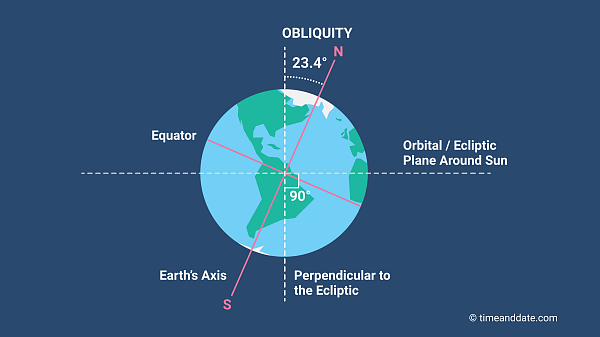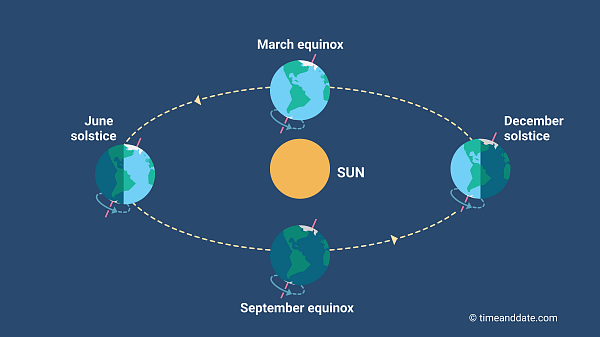What Is Earth's Axial Tilt or Obliquity?
When an object the size of Mars is thought to have crashed into the newly formed planet Earth around 4.5 billion years ago, it knocked our planet over and left it tilted at an angle.


Earth's axis is the imaginary red line.
timeanddate.com
Earth's Axis Is Imaginary
In astronomy, an axis refers to the imaginary line that an object, usually a planet, rotates around.
Earth's rotational axis is an imaginary straight line that runs through the North and South Pole. In our illustrations, Earth's axis is drawn as a straight red line.
Giant Impact Hypothesis
The impact around 4.5 billion years ago is described in the Giant Impact Hypothesis, which is the current prevailing theory on how the Moon was formed and how Earth got its tilt.
Ever since this impact, Earth has been orbiting the Sun at a slant. This slant is the axial tilt, also called obliquity.
Earth's obliquity angle is measured from the imaginary line that runs perpendicular to another imaginary line; Earth's ecliptic plane or orbital plane (see illustration).
At the moment, Earth's obliquity is about 23.4 degrees and decreasing. We say 'at the moment' because the obliquity changes over time, although very, very slowly.
Earth's Obliquity Today
Today, on 2025年1月8日水曜日 at noon, Earth's axial tilt, or mean obliquity was 23.43602° or 23°26'09.6".
Earth's mean obliquity today is about 0.00001°, or 0.04", less than 30 days ago.
The Arctic and Antarctic circles today are 1.2 m (4 ft) closer to the poles, and the Tropic of Cancer and Tropic of Capricorn are equally closer to the equator than 30 days ago.
The Tilt Changes
In a repeating cycle that lasts about 41,000 years, Earth's axial tilt oscillates between 22.1 and 24.5 degrees. This change in obliquity is caused by gravitational forces from the Sun, the Moon, and other planets.
Acts Like Two Spinning Tops
Axial precession can be described as a slow gyration of Earth's axis about another line intersecting it. A complete wobble of Earth's axis takes around 26,000 years. It outlines the shape of a pair of cones or two spinning tops connected at the tips, which would be at the center of Earth.
Ancient Discovery
Greek astronomer Hipparchus of Nicea is historically credited as the man who first proposed that Earths axis gradually shifts, though very slowly. Hipparchus made his discovery around 130 BCE, based on comparisons of astronomical observations more than a century apart.


Earth orbits the Sun at a slant, which is why we have different seasons.
©timeanddate.com
Tilt Causes Seasons
Because Earth orbits the Sun at an angle, the solar energy reaching different parts of our planet is not constant, but varies during the course of a year.
This is the reason we have different seasons and why the seasons are opposite in the Northern and Southern Hemispheres.
Opposite Seasons
Astronomical & meteorological seasons
From the March equinox to the September equinox, the Northern Hemisphere tilts towards the Sun. During this time, there are more than 12 hours of daylight north of the equator.
What are equinoxes and solstices?
Our point of view of Earth may vary, but the axis always tilts the same way. ©bigstockphoto.com/subodhsathe
At the same time, the Southern Hemisphere tilts away from the Sun, resulting in shorter days.
From the September equinox to the next March equinox, the days are longer south of the equator and shorter north of the equator.
Illustrator's Point of View
Different illustrators may vary which direction they incline the axis in their images. Some draw it tilted left-to-right, others right-to-left. These illustrations can both be accurate; the only difference is that the artist has chosen the opposite side of the Sun as the point-of-view.